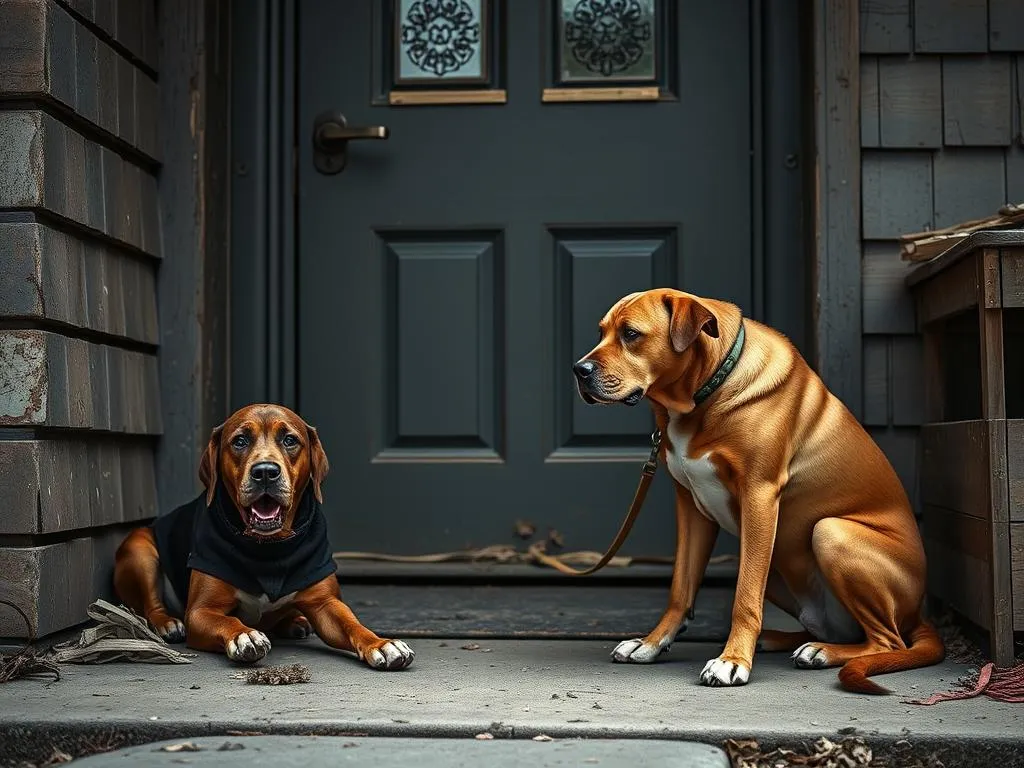
Introduction
In recent years, home security concerns have escalated dramatically. With rising crime rates and an increasingly unpredictable world, homeowners are more vigilant than ever about safeguarding their properties. As a result, many individuals are exploring various methods to enhance their security, ranging from advanced alarm systems to neighborhood watch programs. Amidst these discussions, one surprisingly effective deterrent often overlooked is man’s best friend: the dog.
Dogs have long been revered not only for their companionship but also for their innate protective instincts. Whether it’s a gentle Golden Retriever or a steadfast German Shepherd, dogs can become formidable guardians of our homes. This article will explore how dogs can deter break-ins and the factors that influence their effectiveness as protectors.
Understanding Dog Behavior
Natural Instincts
To comprehend how dogs prevent break-ins, it’s essential to understand their natural instincts. Historically, dogs have been bred for various purposes, including hunting, herding, and guarding. Breeds like the Rottweiler and Doberman Pinscher have been specifically cultivated for their protective traits. These dogs possess an inherent desire to protect their territory and their human companions, making them natural guardians.
This protective instinct is a remnant of their ancestors, who would guard their packs against predators and intruders. Therefore, a dog’s natural inclination to alert their owner of potential threats can serve as a crucial deterrent against burglars.
Socialization and Training
While natural instincts play a significant role, socialization and training are critical components in shaping a dog’s behavior. A well-socialized and trained dog is more likely to exhibit effective guarding behavior. Training that focuses on obedience can enhance a dog’s ability to follow commands, which is vital in a threatening situation.
Moreover, specific training geared towards guarding can further refine these protective instincts. This includes teaching dogs to bark on command, alerting their owners of unusual activity. The more a dog is trained and socialized, the more effective they can be in deterring potential break-ins.
Breed Characteristics
Not all dog breeds are equally effective at deterring intruders. Certain breeds have long been recognized for their guarding abilities. Here’s a brief overview of some popular breeds known for their protective nature:
- German Shepherd: Highly intelligent and versatile, they excel in protection and obedience.
- Rottweiler: Fearless and confident, they are natural guardians of home and family.
- Doberman Pinscher: Loyal and alert, they are often used as police and guard dogs.
- Bullmastiff: Known for their strength, they are excellent at intimidating intruders.
When choosing a dog for security purposes, it’s essential to consider the breed and its characteristics. Understanding which breeds have the potential to protect can lead to more informed decisions for homeowners.
The Psychology of Burglars
Burglars’ Motivations and Strategies
To understand how dogs prevent break-ins, one must delve into the psychology of burglars. Burglars are typically motivated by opportunity, seeking out homes that appear easy to access. They often observe a neighborhood before choosing a target, looking for signs of vulnerability such as poor lighting or an absence of security measures.
Common methods employed by burglars include checking for unlocked doors, scouting for valuables visible through windows, and monitoring the presence (or absence) of residents. A home that appears occupied or has visible security measures is less likely to be targeted.
Perception of Dogs
The presence of a dog can significantly influence a burglar’s decision-making process. Many burglars cite the fear of encountering a dog as a primary deterrent. In fact, studies have shown that homes with dogs are less likely to be targeted compared to those without.
A 2013 survey conducted by a security company revealed that over 60% of burglars would avoid a property if they knew a dog was present. This statistic highlights the psychological impact that dogs can have on potential intruders, reinforcing the idea that dogs prevent break-ins effectively.
Case Studies and Statistics
Real-Life Testimonials
Personal anecdotes can be powerful indicators of how dogs contribute to home security. Many homeowners have shared stories of how their dogs alerted them to suspicious activity, ultimately preventing a break-in. For instance, a homeowner in a suburban neighborhood reported that their Labrador Retriever barked ferociously at night, alerting them to an intruder attempting to enter through a back door. This quick response not only scared off the intruder but also provided peace of mind to the family.
Additionally, law enforcement officials often acknowledge the role of dogs in crime deterrence. Officers have noted that houses with dogs tend to experience fewer break-ins, attributing this phenomenon to the noise and presence of a canine companion.
Research Data
Several studies support the notion that homes with dogs experience lower break-in rates. Research from the University of North Carolina indicated that homes with dogs are 50% less likely to be targeted by burglars than those without. This statistical evidence underscores the effectiveness of dogs as a security measure.
Furthermore, data comparing neighborhoods with varying dog ownership levels shows a clear correlation between dog presence and reduced crime rates. In areas where dog ownership is prevalent, reports of burglaries and property crimes have decreased significantly.
Additional Security Measures
Complementary Home Security Systems
While dogs can be effective deterrents, they should be part of a broader security strategy. Integrating technology such as security cameras, alarm systems, and motion sensors can enhance the overall safety of a home. For instance, a dog can alert homeowners to a potential threat, while a security system can provide additional monitoring and alerts.
Moreover, visible security signs indicating the presence of a dog, combined with other security measures, can significantly discourage potential intruders. A comprehensive security plan that includes both a vigilant dog and technological solutions creates a formidable barrier against break-ins.
Neighborhood Watch and Community Efforts
Community cooperation can also bolster home security alongside pet ownership. Neighborhood watch programs encourage residents to look out for one another, creating a united front against crime. Dog owners can play a vital role in these initiatives by being extra vigilant during walks and reporting suspicious activities.
Moreover, collaboration between dog owners and neighborhood watch groups can enhance collective security measures. For example, dog owners can organize regular patrols in their communities, using their pets as both companions and protectors.
Challenges and Limitations
Misconceptions About Dog Ownership
Despite the many advantages of having a dog for security, there are common misconceptions that can lead to unrealistic expectations. One prevalent myth is that every dog, regardless of size or breed, can effectively protect a home. While many dogs have protective instincts, not all are suited for guarding responsibilities.
Additionally, some individuals believe that simply owning a dog is sufficient for home security. This notion overlooks the importance of proper training and socialization. A well-trained dog can be a powerful deterrent, while an untrained dog may not respond effectively to threats.
Risks Involved
There are situations where dogs may not be effective in preventing break-ins. For instance, trained burglars may use tactics to distract or incapacitate a dog, rendering them less effective as protectors. Furthermore, families with young children or other pets must consider the dynamics involved. A protective dog might pose risks if not properly socialized with children or other animals.
It’s also crucial for dog owners to understand their pet’s temperament and behavior. While many dogs are naturally protective, they may react unpredictably in stressful situations. Responsible ownership and training are essential to ensure that dogs remain a positive force in home security.
Conclusion
In conclusion, the question of whether dogs prevent break-ins is multifaceted. Dogs possess natural protective instincts, enhanced through proper training and socialization. Their presence alone can deter potential intruders, supported by a wealth of statistics and real-life testimonials.
However, it’s vital to remember that dogs should be part of a comprehensive home security plan that includes technology and community efforts. By understanding the challenges and limitations associated with dog ownership, families can make informed decisions about their security.
Ultimately, responsible dog ownership not only enriches lives but also enhances the safety and security of homes. Embracing the protective qualities of dogs can lead to a more secure living environment for families everywhere.









